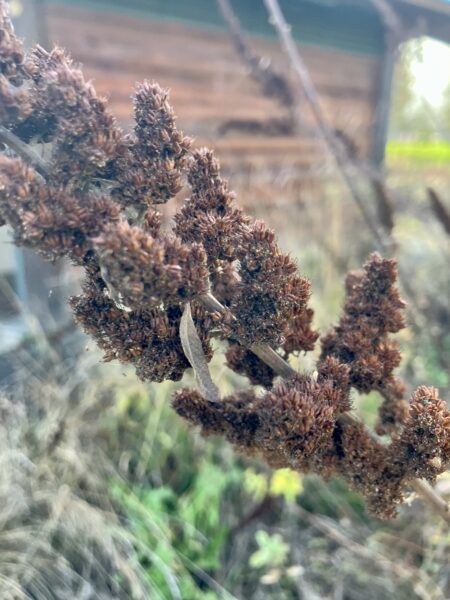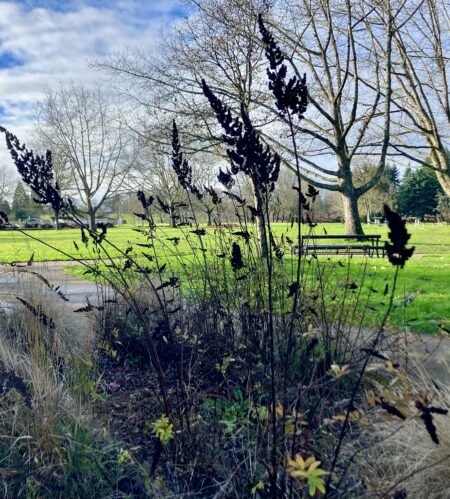January Velvet
January 15, 2024

Soft-fogged darkness,
muted winter mornings,
a warm mug of strong brew,
and the swaying wands
of Douglas Spiraea’s seedheads
in complementary hue—
rich as earth.
Whorled outreaching form
rising to ungloved touch,
as plumply furred as
a small creature
crawling from hibernation,
angled sunward,
against the weight
of rain.
See their resilient charm:
proud heads
on slender stems,
above blonde grasses
and wind-tattered perennials,
dark arms atwirl—
the after-party
where pink chintz is shed
for little black dress.
Pollen-filled youth of blushed bloom,
merrily visited by butterflies and bees,
wanes.
Summer passes into fall,
and now,
winter bares
beautiful bones,
strikingly dark,
luxurious as velvet.
When all things
lie limp,
bent by cloud weight
and cold,
my eye celebrates
the uplift of
Douglas Spiraea
in seed.

You’d think the plant of the month for the heart of winter would be an evergreen. The standard advice is to include at least a third of those in your garden if you want something pleasant to look at now. And, indeed, that’s fine advice. I could have lauded any number of favorite coniferous or broadleaf evergreens to add to your garden for January beauty.
Instead, this month, I give you a new look at the best seedheads on a Pacific Northwest deciduous shrub: Douglas Spiraea (or, rather redundantly: Spiraea dougalsii).
The thing I want you to know about this plant is that its winter grace is only revealed when you act with the renewing force of a flooding river. Coppice it, chop it all down, prune it back hard, just as a flood does, unsparingly, every few winters or so.
Where our native spiraea grows in the wild along river banks, this is their natural experience of growth: a good, periodic whacking. When these plants sprout anew from bank-anchoring roots in the spring, their growth is willowy-fresh, uncrowded by old stems. The resulting shrub is shorter with summer blooms at head-height.
Do not follow the lead of mow-and-blow landscapers who indiscriminately shear it throughout the growing season into a too-short meatball or tightly-formal hedge. Douglas spiraeas treated this way have none of the winter beauty of wild grown plants. They’re often prevented from blooming, let alone sporting proud winter seedheads. Dense with twigs, the willowy grace is lost. It’s a shame. I feel bad for those victims of neat and tidy, power-tool-fueled compulsion.
But, you know better. You can observe nature and follow her lead. Sharpen your hand saws and pruners. That overly large Douglas Spiraea in your garden is ready for the flood.

I did not know I could chop them back. I got mine as a stop way in another plant.
I love the Mahonias and Kinnikinnick for winter greens. We good y allow evergreens within 30 or 50 feet of the house because of fire. We live in north central Washington and our sagebrush hadn’t burned in at least 50 years….
What a great plant to get as a stow away, Lisa! Yes, you can cut it back to the ground in February or March, just before the new growth of spring. It’s a great way to keep it in scale in a home garden.
I agree, mahonias and kinnikick are fantastic evergreens, ceanothus, too where hardy.